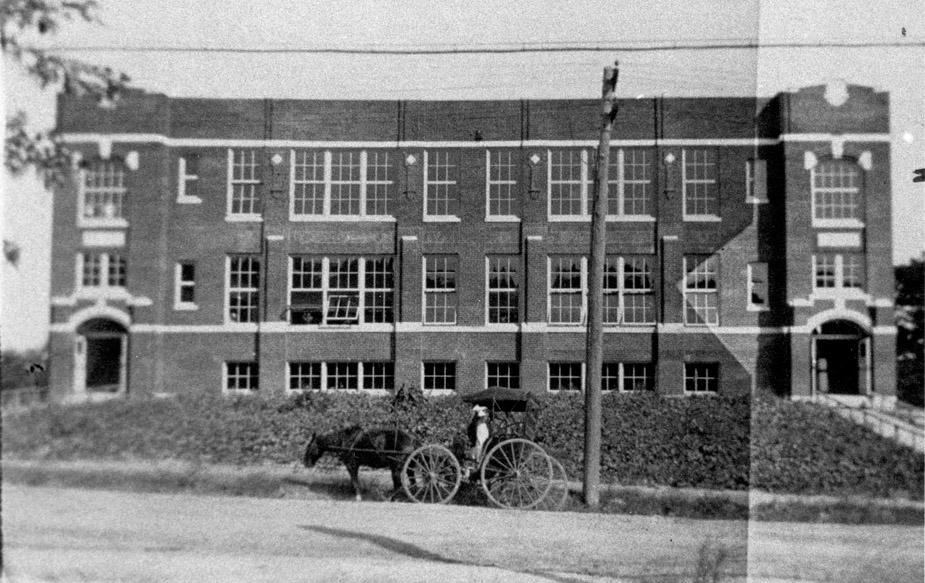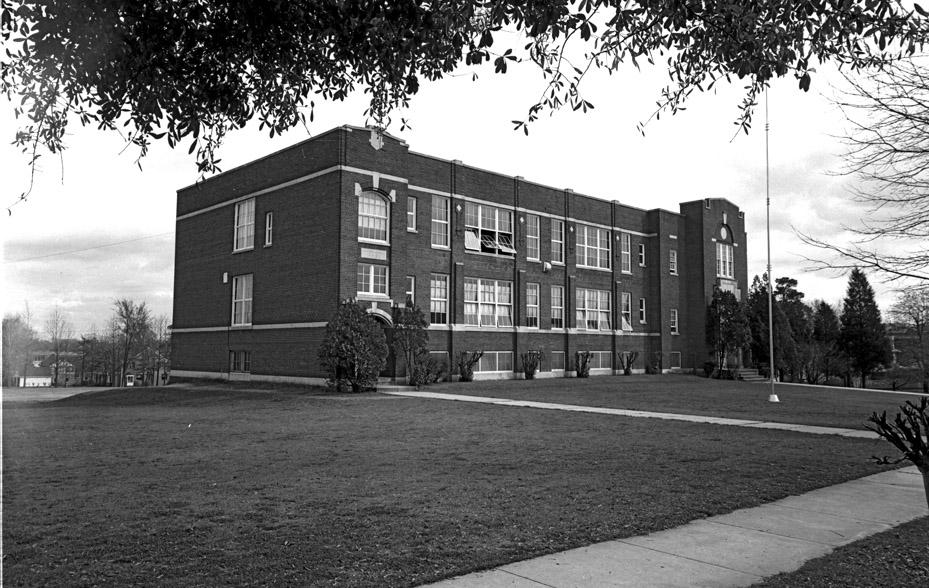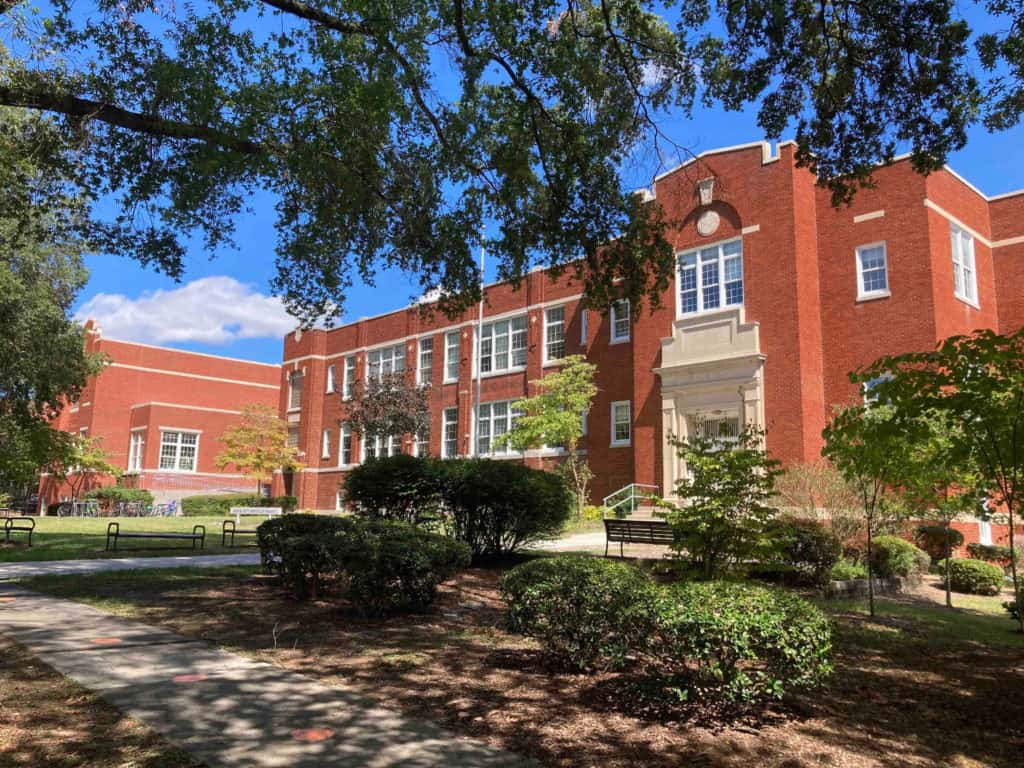By Dale Pahl
Thirty years ago, the Trinity Park Neighborhood Association (TPNA) completed a multi-year effort to rescue George Watts Elementary School from state policies and local recommendations that threatened its existence. Completed in 1918, this school is Durham’s oldest active elementary school; it is located on about 4 acres of land in the heart of Trinity Park and served about 290 students in 1990. Today, this historic elementary school is known as George Watts Montessori Magnet Elementary.

This brief article reviews the public policy issues that created the crises which threatened our neighborhood school, describes the strategy to save the school, and underscores the public benefits of the outcomes achieved by TPNA and neighborhood leaders.
The National Trust for Historic Preservation viewed our neighborhood’s success story as so significant that it highlighted it in one of its national publications and in its 2001 workshop on saving historic local schools for national, state, and local policy directors. A presentation from this workshop and several other documents about our effort and the national policy issues are included at the end of this article.
A Growing Crisis for Historic Schools
The 1980’s witnessed the growth of a “slow crisis” that threatened local historic schools across the nation. State legislatures and school boards inadvertently contributed to this crisis as they grappled with limited budgets, growing student populations, the need to modernize deteriorating school buildings, and increasingly stringent facility standards. An informal nationwide movement emerged that had the effect of replacing small, old, urban schools with modern new facilities built on large suburban tracts of land. Frequently, this informal movement was exacerbated by state consultants that helped develop new school facility standards which historic local schools were unable to meet. Ironically, many educators and community leaders viewed historic local elementary schools as important and cohesive contributors to early childhood education, to the schools’ neighborhoods, and to their sense of community.
In North Carolina, the state Department of Public Instruction (DPI) published new school facility guidelines by 1990 that did not support historic local elementary schools. Facility guidelines recommended that elementary schools serve >450 students, occupy > 14 acres of land, include classrooms ranging from 850-1200 ft2, meet Class II fire standards, and include a 1-floor footprint. The DPI facility guidelines did not include policies for historic preservation or for prevention of suburban sprawl; apparently architects with expertise in these areas were not consulted when these guidelines were developed and approved.
This slow crisis became an urgent one as the Durham Public Schools Board of Education (informally, the Durham school board) considered the impending merger with Durham County Schools. Simultaneously, the Durham school board recognized that about $40 million in facility bond funds had not been allocated for specific projects. The Durham school board also recognized that only a year remained before consolidation of the two school systems and therefore created a top priority to evaluate three older elementary schools—E.K. Powe, George Watts, and Club Boulevard—as potential candidates for repair or renovation. (Any unallocated bond money would be integrated with bond funds for the consolidated school system). As the school board conducted this evaluation, it also:
- Wrestled with concerns from citizens and stakeholder groups about decaying school infrastructure, merger with the surrounding county school system, and finances.
- Agreed that all schools should comply with all facility standards and safety codes related to fire, safety, and handicap accessibility.
- Relied on consultants for expert advice about school facilities and authorized them to conduct feasibility studies about school renovation and construction.
Consultant’s Assessment Recommends Closure
In early 1992, an informal assessment prepared by one of these consultants indicated that Watts School did not meet guidelines prepared by the NC DPI and recommended closing the school. The Durham Board of Education indicated that this assessment precluded renovating Watts Elementary School and that the Board would make final decisions about its older elementary schools by the end of June 1992.
Fortunately, the neighborhood and TPNA were alerted to these challenges by neighbors serving on the School Board, on Durham’s Inter Neighborhood Council (INC), and on the Watts PTA. TPNA and its residents were very aware of the neighborhood impacts from loss of a local school. “Our school system had a lot of empty buildings sitting all over the place . . . They were boarded up all over the city. Two schools had even burned down. So [sic] we worried that closing Watts would create a blight in our neighborhood” recalled Linda Wilson.*
The Neighborhood Response
The first meeting to develop a TPNA response to these challenges took place at the home of Dr. Curt Eshelman, a neighbor who also served on the Durham school board. “I was in an odd position,” recalled Eshelman. “I wanted to see the Watts School saved, but as a school board member, I couldn’t vote to renovate the school unless we could demonstrate that that was doable.”* Ultimately, the TPNA strategy that guided its response was to:
- Request that the Durham Board of Education form a citizen’s Advisory Committee to evaluate the consultant’s feasibility reports and recommendations—and that the Committee’s members represent all three neighborhood schools being studied by the school board.
- Conduct an independent analysis of the consultant’s Watts School study and prepare an independent renovation plan, feasibility study, and cost estimate for the Watts School—and report both results to the Advisory Committee and Durham school board.
- Work with the Advisory Committee to create an evidence-based written report about all three neighborhood schools and distribute this report widely to the school board, City Council, Inter-Neighborhood Council, and local media.
Because of the decision-making timetable established by the Durham school board, the TPNA team implementing this strategy had less than five months to complete it. The team included a neighborhood architect, the owner of a plumbing company, and an engineer (Sam Hodges, Larry Tilley, and Dale Pahl). Valuable support for their report on George Watts—and for the report on all three elementary schools prepared with help from the Advisory Committee—was provided by George Watts Principal Delia Robinson and by the E.K. Powe PTA representative Ted Compton. These two reports provided crucial evidence to support these conclusions:
- The consultant’s assessment of Watts School for the Durham Board of Education was incomplete, it did not consider an option to renovate the school, and many of its recommendations were not supported by valid data.
- Architectural, engineering, and cost analyses to renovate Watts School demonstrated that: (a) renovation was feasible, (b) renovation would enable the school to comply with virtually all state school facility standards, (c) the costs to renovate compared favorably to recent costs incurred to build new schools or renovate existing schools in the Raleigh-Durham area, and (d) renovation would be cost-effective even for a student population almost fifty percent larger than the school’s existing 290 students.
School Board Decision and School Renovation
The team’s evidence and the Advisory Committee’s reports persuaded the Durham school board to accept proposals to renovate all three local schools, and to grant Watts School a waiver to the State requirement for a 14-acre site for elementary schools and for the state guideline that elementary school classrooms should have a ground-level footprint. Based on these decisions, TPNA then led a successful campaign, with support from the INC and the school PTAs, to approve a school bond with sufficient funds to renovate all three local schools. The Durham school board ultimately approved about $12 million for the three local elementary schools. Before the end of 1993 (thirty years ago) Eddie Belk of ARDA—a Durham architect with significant renovation experience—was instrumental in the design of the Watts School renovation. In addition to renovating and improving the existing building, Belk’s design created a new addition that matched the art deco and neoclassical character of the original Watts School façade. With a renovation cost of about $4 million (for an expanded footprint of about 66,000 ft2) Watts School aimed to serve about 320 students.


By way of comparison, the recent expansion and renovation of the Club Boulevard elementary school that is scheduled for completion in 2023 will include a 57,000 ft2 building on 5.1 acres of land with a cost about $7.1 million. Of course, capital investments for new elementary schools are more than an order-of-magnitude smaller that those for new high schools. For example, the new Northern High School, which opened in August 2023, includes 250,000 ft2of buildings that will house 1,600 students and cost about $95 million.
Public Value of the TPNA and Volunteer Efforts
This brief history of the successful rescue and renovation of Watts School in 1992-93 highlights the public benefits created by TPNA and its neighborhood volunteers. In monetary terms, the value of the renovated Watts School to Durham was at least $4 million based on work completed in the 1990’s. As a cohesive centerpiece for the Trinity Park neighborhood and its families, the school’s value is priceless.
This brief history also illustrates several civic principles that guide TPNA and its volunteers:
- Representing the Trinity Park neighborhood requires communication and coordination with stakeholders across the City of Durham: ideally, with volunteers who serve on the inter- neighborhood council, who attend city council committee meetings, and who serve on other relevant boards and committees such as the Durham school board.
- Representing the neighborhood also requires strategic thinking: to extend awareness beyond routine civic affairs, to identify both slow and acute crises, and to dedicate substantial time and effort needed to create and implement strategies to resolve them.
- When solving significant problems such as the crisis described here, municipal governments and organizations such as the Durham school board frequently respect contributions by nonprofit organizations such as TPNA when their proposed solutions represent and benefit as many stakeholders as possible.
Acknowledgements and Resources
In closing, two acknowledgments are needed. First, thanks to Trinity Park neighbors Dr. Curt Eshelman, Larry and Leanne Tilley, and Linda Wilson for reviewing and commenting on the draft version of this article. Second, the documents below were highlighted by Constance Beaumont, Director of State and Local Policy for the National Trust for Historic Preservation, during a July 2001 training workshop about historic neighborhood schools:
- Why Johnny Can’t Walk to School: Historic Neighborhood Schools in the age of Sprawl (report by the National Trust for Historic Preservation)
- Feasibility Study for George Watts Elementary School (1992)
- Report to the Durham City Schools Board of Education: Recommendations for E.K. Powe, George Watts, and Club Boulevard Elementary Schools (1992)
- When Historic Neighborhood Schools Are Threatened: The Watts Elementary School Experience (2001)
* Beaumont, C.E. and Pianca, E.G. “Historic Neighborhood Schools in the age of Sprawl: Why Johnny Can’t Walk to School,” pages 26 and 27. National Trust for Historic Preservation, November 2000.
